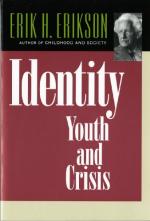
|
| Name: _________________________ | Period: ___________________ |
This test consists of 15 multiple choice questions and 5 short answer questions.
Multiple Choice Questions
1. Who does Erikson use as an example to discuss the identity of blacks?
(a) C.S. Lewis.
(b) Martian Luther King.
(c) Freud.
(d) W.E.B. DuBois.
2. What is the nature of psychoanalysis as viewed by Erikson?
(a) Explicit.
(b) Empirical.
(c) Implicit.
(d) Observational.
3. What does Erikson state the ego is in that it knows and understands where it wants to go?
(a) Intelligent.
(b) Forward looking.
(c) Whole.
(d) Introspective.
4. What does Erikson suggest defines much of a woman's identity?
(a) Who she marries.
(b) How many children she has.
(c) Intelligence.
(d) Attractiveness to men.
5. What do many youth move back and forth between in terms of dysfunctional modes of Erikson's theory of identity development?
(a) Devoted conformity and extreme deviancy.
(b) Devoted conformity and devotion to self.
(c) Mild conformity and mild deviancy.
(d) Extreme deviancy and repentance.
6. What do youth recognize the need for during Erikson's stages of identity development?
(a) Loyalty.
(b) Friends.
(c) Family.
(d) Community.
7. How does Erikson feel various features of humanity should be examined?
(a) Through discussion.
(b) They need not be examined.
(c) Empirically.
(d) Through observations.
8. What does Erikson say must not happen with strong black mothers?
(a) They must continue their struggles.
(b) They must not be negatively stereotyped.
(c) They must not be so overbearing.
(d) They must not be positively stereotyped.
9. According to Erikson's theory, what is psychologically different between males and females?
(a) Everything.
(b) Their notions of success.
(c) Their psychological spaces.
(d) Their ability to express empathy.
10. What does Erikson say about the absence of black fathers?
(a) It is physically.
(b) It is the downfall of the race.
(c) It is only psychologically.
(d) It is the only reason for identity confusion.
11. Who does Erikson suggest black be integrated with?
(a) Only the majority.
(b) Other minorities.
(c) Americans with a more exclusive identity.
(d) Americans with a more inclusive identity.
12. Where does Erikson feel ego strength some from in youth?
(a) Confirmation of conformity.
(b) Parents.
(c) Confirmation of individuality.
(d) Community.
13. Why does Erikson state that remorseful majorities be watched?
(a) They may not really be remorseful.
(b) They may become oppressed.
(c) They may lose their identity.
(d) They may repeat habitual patterns.
14. What does Erikson suggest occurs in institutionalized settings such as a hospital with regard to identity?
(a) Development of oneliness.
(b) Conformity of identity.
(c) Emergence of self.
(d) Desperation for identity.
15. What type of feelings does Erikson proposed are experienced by those in oppressed groups?
(a) Indifference and loathing.
(b) Superiority and self-love.
(c) Interest in other groups.
(d) Inferiority and self-hate.
Short Answer Questions
1. What, according to Erikson, is destructive for blacks?
2. Considering Erikson's theory of group identity development, what are cultures often led to do concerning their values?
3. What according to Erikson, what involves testing, selecting, and integrating self images?
4. What are women able to process better than men, according to Erikson?
5. What does Erikson wish youth would search for?
|
This section contains 479 words (approx. 2 pages at 300 words per page) |

|




